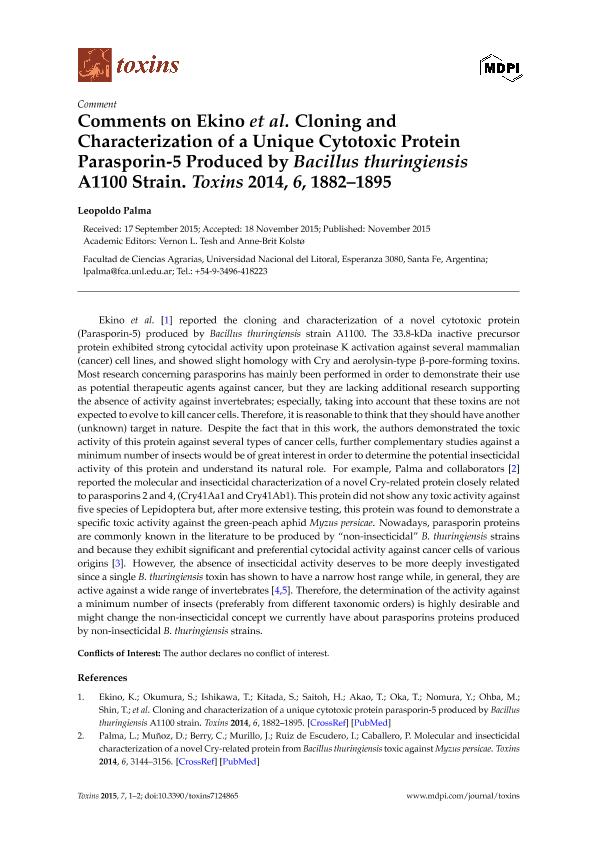Mostrar el registro sencillo del ítem
dc.contributor.author
Palma, Leopoldo

dc.date.available
2018-06-22T21:26:36Z
dc.date.issued
2015-11
dc.identifier.citation
Palma, Leopoldo; Comments on Ekino et al. Cloning and Characterization of a Unique Cytotoxic Protein Parasporin-5 Produced by Bacillus thuringiensis A1100 Strain. Toxins 2014, 6, 1882–1895; MDPI; Toxins; 7; 12; 11-2015; 5094-5095
dc.identifier.issn
2072-6651
dc.identifier.uri
http://hdl.handle.net/11336/49815
dc.description.abstract
Ekino et al. [1] reported the cloning and characterization of a novel cytotoxic protein (Parasporin-5) produced by Bacillus thuringiensis strain A1100. The 33.8-kDa inactive precursor protein exhibited strong cytocidal activity upon proteinase K activation against several mammalian (cancer) cell lines, and showed slight homology with Cry and aerolysin-type -pore-forming toxins. Most research concerning parasporins has mainly been performed in order to demonstrate their use as potential therapeutic agents against cancer, but they are lacking additional research supporting the absence of activity against invertebrates; especially, taking into account that these toxins are not expected to evolve to kill cancer cells. Therefore, it is reasonable to think that they should have another (unknown) target in nature. Despite the fact that in this work, the authors demonstrated the toxic activity of this protein against several types of cancer cells, further complementary studies against a minimum number of insects would be of great interest in order to determine the potential insecticidal activity of this protein and understand its natural role. For example, Palma and collaborators [2] reported the molecular and insecticidal characterization of a novel Cry-related protein closely related to parasporins 2 and 4, (Cry41Aa1 and Cry41Ab1). This protein did not show any toxic activity against five species of Lepidoptera but, after more extensive testing, this protein was found to demonstrate a specific toxic activity against the green-peach aphid Myzus persicae. Nowadays, parasporin proteins are commonly known in the literature to be produced by “non-insecticidal” B. thuringiensis strains and because they exhibit significant and preferential cytocidal activity against cancer cells of various origins [3]. However, the absence of insecticidal activity deserves to be more deeply investigated since a single B. thuringiensis toxin has shown to have a narrow host range while, in general, they are active against a wide range of invertebrates [4,5]. Therefore, the determination of the activity against a minimum number of insects (preferably from different taxonomic orders) is highly desirable and might change the non-insecticidal concept we currently have about parasporins proteins produced by non-insecticidal B. thuringiensis strains.
dc.format
application/pdf
dc.language.iso
eng
dc.publisher
MDPI
dc.rights
info:eu-repo/semantics/openAccess
dc.rights.uri
https://creativecommons.org/licenses/by-nc-sa/2.5/ar/
dc.subject
Bacillus Thuringiensis
dc.subject
Bt Toxins
dc.subject
Anti Cancer Activity
dc.subject
Parasporins
dc.subject.classification
Otras Ciencias Biológicas

dc.subject.classification
Ciencias Biológicas

dc.subject.classification
CIENCIAS NATURALES Y EXACTAS

dc.title
Comments on Ekino et al. Cloning and Characterization of a Unique Cytotoxic Protein Parasporin-5 Produced by Bacillus thuringiensis A1100 Strain. Toxins 2014, 6, 1882–1895
dc.type
info:eu-repo/semantics/article
dc.type
info:ar-repo/semantics/artículo
dc.type
info:eu-repo/semantics/publishedVersion
dc.date.updated
2018-05-04T21:44:19Z
dc.journal.volume
7
dc.journal.number
12
dc.journal.pagination
5094-5095
dc.journal.pais
Suiza

dc.journal.ciudad
Basel
dc.description.fil
Fil: Palma, Leopoldo. Universidad Nacional del Litoral. Facultad de Ciencias Agrarias; Argentina. Consejo Nacional de Investigaciones Científicas y Técnicas. Centro Científico Tecnológico Conicet - Santa Fe; Argentina
dc.journal.title
Toxins
dc.relation.alternativeid
info:eu-repo/semantics/altIdentifier/doi/http://dx.doi.org/10.3390/toxins7124865
dc.relation.alternativeid
info:eu-repo/semantics/altIdentifier/url/http://www.mdpi.com/2072-6651/7/12/4865
Archivos asociados
